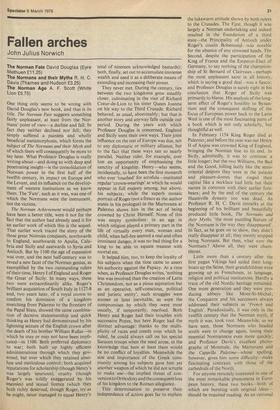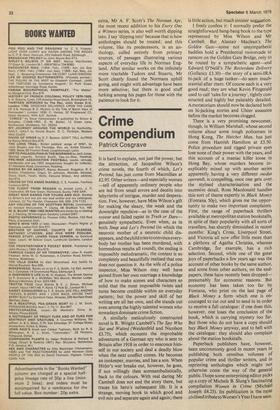Fallen arches
John Julius Norwich The Norman Fate David Douglas (Eyre Methuen £11.25) The Normans and their Myths R. H. C. Davis (Thames and Hudson £3.25) The Norman Age A. F. Scott (White Lion £5.75) One thing only seems to be wrong with David Douglas's new book, and that is its title. The Norman Fate suggests something fairly unpleasant, at least from the Normans' point of view—a decline and fall. In fact they neither declined nor fell; they simply suffered a painless and wholly beneficial metamorphosis, which forms the subject of The Normans and their Myth and of which there will consequently be more to say later. What Professor Douglas is really writing about—and doing so with deep and penetrating insight—is the consolidation of Norman power in the first half of the twelfth century, its impact on Europe and the Levant, and its influence on the development of western institutions as we know them. The 'Fate', such as it was, was one of which the Normans were the instrument, not the victims.
The Norman Achievement would perhaps have been a better title, were it not for the fact that the author had already used it for an earlier work of which this is the sequel. That earlier work traced the story of the three great Norman conquests, northwards to England, southwards to Apulia, Calabria and Sicily and eastwards to Syria and Antioch. But by 1100 the age of expansion was over, and the next half-century was to reveal a new facet of the Norman genius, as exemplified by the two outstanding rulers of their time, Henry I of England and Roger the Great of Sicily. In many ways, these two were extraordinarily alike. Roger's brilliant acquisition of South Italy in 1127-8 and, two years later, of a royal crown to confirm his dominion of a kingdom stretching from Palermo to the frontiers of the Papal State, showed the same combination of decisive statesmanship and quick thinking as Henry had demonstrated by his lightning seizure of the English crown after the death of his brother William Rufus—in which he may or may not have been implicated—in 1100. Both preferred diplomacy to war; both built up highly efficient administrations through which they governed, but over which they retained absolute and meticulous control; both acquired reputations for scholarship (though Henry's was largely spurious), cruelty (though Roger's was wildly exaggerated by his enemies) and sexual licence (which they both richly deserved, though Roger, try as he might, never managed to equal Henry's
total of nineteen acknowledged bastards); both, finally, set out to accumulate immense wealth and used it as a deliberate means of extending and increasing their power.
They never met. During the century, ties between the two kingdoms grew steadily closer, culminating in the visit of Richard Coeur-de-Lion to his sister Queen Joanna on his way to the Third Crusade. Richard behaved, as usual, abominably; but that is another story and anyway falls outside our period. During the years with which Professor Douglas is concerned, England and Sicily went their own ways. Their joint influence on the rest of Europe was due, not to any diplomatic or military alliance, but to the fact that these ways ran so nearly parallel. Neither ruler, for example, ever lost an opportunity of emphasising the sanctity of kingship. Henry—who seems, incidentally, to have been the first monarch who ever 'touched' for scrofula—instituted regular 'crown-wearings' at which he would appear in full majesty among, but above, his subjects; while the superb mosaic portrait of Roger (not a fresco as the author states in his prologue) in the Martorana at Palermo shows him in the act of being crowned by Christ Himself. None of this was empty symbolism: in an age in which religion played a primary part in the life of virtually every man, woman and child, when hell-fire seemed a real and often imminent danger, it was no bad thing for a king to be able to equate treason with mortal sin.
It helped him, too, to keep the loyalty of his subjects when the time came to assert his authority against the Papacy. At a time when, as Professor Douglas writes, 'nothing less was involved than the creation of Latin Christendom, not as a pious aspiration but as an operative, self-conscious, political and juristic entity', such struggles were sooner or later inevitable, as were the compromises by which they were most usually, if temporarily, resolved. Both Henry and Roger had their troubles with successive Popes, but here Roger had the distinct advantage: thanks to the multiplicity of races and creeds over which he ruled, he could always call on his special Saracen troops when the need arose, in the knowledge that here at least there would be no conflict of loyalties. Meanwhile the size and importance of the Greek community among his subjects gave him yet another weapon of which he did not scruple to make use—the implied threat of conversion to Orthodoxy and the conseq uent loss of his kingdom to the Roman allegiance.
This determination to preserve their independence of action goes far to explain the lukewarm attitude shown by both rulers to the Crusades. The First, though it was largely a Norman undertaking and indeed resulted in the foundation of a third state—the Principality of Antioch under Roger's cousin Bohemuncl—was notable for the absence of any crowned heads. The Second, despite the participation of the King of France and the Emperor-Elect of Germany, to say nothing of the championship of St Bernard of Clairvaux—perhaps the most unpleasant saint in all history, which is saying a good deal—was a fiasco; and Professor Douglas is surely right in his conclusion that Roger of Sicily was primarily to blame. His analysis of the longterm effect of Roger's hostility to Byzantium and the consequent shifting of the focus of European power back to the Latin West is one of the most fascinating parts of a book which is not only scholarly, but thoughtful as well.
In February 1154 King Roger died at Palermo; and before the year was out Henry II of Anjou was crowned King of England, bringing the Norman line to its end. In Sicily, admittedly, it was to continue a little longer; but the two Williams, the Bad and the Good, lolling lazily like the semioriental despots they were in the palaces and pleasure-domes that ringed their capital like a necklace had little but their names in common with their earlier forebears; and by the end of the century the Hauteville dynasty too was dead. As Professor R. H. C. Davis remarks at the beginning of his brilliant and beautifully produced little book, The Normans and their Myths. 'the most puzzling feature of the Normans is the way they disappeared'. In fact, as he goes on to show, they didn't really disappear at all ; they merely stopped being Normans. But then, what were the Normans? Above all, they were chameleons.
Little more than a century after the first pagan Vikings had sailed their longboats up the Seine, their grandchildren were growing up as Frenchmen, in language, religion and political institutions. Hardly a trace of the old Nordic heritage remained. One more generation and they were producing abbeys like Mont-St-Michel; the Conqueror and his successors always addressed their subjects as 'French and English'. Paradoxically, it was only in the twelfth century that the Norman myth, if myth it was, took root. Meanwhile, as we have seen, those Normans who headed south were to change again, losing their essential Normanness even more quickly; and Professor Davis's excellent photographs of Monreale, the Martorana and the Cappella Palatina—whose spelling, however, gives him some difficulty—make fascinating contrasts with those of the cathedrals of the North.
For anyone remotely interested in one of the most remarkable phenomena in European history, these two books—both of which are bursting with original ideas— should be required reading. As an optional
extra, Mr A. F. Scott's The Norman Age, the most recent addition to his Every One a Witness series, is also well worth dipping into. I say 'dipping into' because that is how anthologies should be treated ; and this volume, like its predecessors, is an anthology, culled entirely from primary sources, of passages illustrating various aspects of everyday life in Norman England. After similar works on the infinitely more tractable Tudors and Stuarts, Mr Scott clearly found the Normans uphill going, and might with advantage have been more selective; but there is good stuff lurking among his pages for those with the patience to look for it.



































 Previous page
Previous page